Examsrevision
On this page, you find all documents, package deals, and flashcards offered by seller ExamsRevision.
- 1070
- 0
- 125
Community
- Followers
- Following
22 Reviews received
1195 items
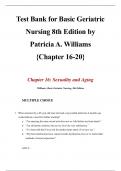
Test Bank for Basic Geriatric Nursing 8th Edition by Patricia A. Williams {Chapter 16-20}
Chapter 16: Sexuality and Aging Chapter 17: Care of Aging Skin and Mucous Membranes Chapter 18: Elimination Chapter 19: Activity and Exercise Chapter 20: Sleep and Rest
- Exam (elaborations)
- • 71 pages •
Chapter 16: Sexuality and Aging Chapter 17: Care of Aging Skin and Mucous Membranes Chapter 18: Elimination Chapter 19: Activity and Exercise Chapter 20: Sleep and Rest
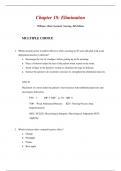
Test Bank for Basic Geriatric Nursing 8th Edition by Patricia A. Williams {Chapter 16-20}
Chapter 16: Sexuality and Aging Chapter 17: Care of Aging Skin and Mucous Membranes Chapter 18: Elimination Chapter 19: Activity and Exercise Chapter 20: Sleep and Rest
- Package deal
- • 5 items •
- Chapter 18: Elimination • Exam (elaborations)
- Chapter 19: Activity and Exercise • Exam (elaborations)
- Chapter 20: Sleep and Rest • Exam (elaborations)
- Chapter 16: Sexuality and Aging • Exam (elaborations)
- Chapter 17: Care of Aging Skin and Mucous Membranes • Exam (elaborations)
Chapter 16: Sexuality and Aging Chapter 17: Care of Aging Skin and Mucous Membranes Chapter 18: Elimination Chapter 19: Activity and Exercise Chapter 20: Sleep and Rest
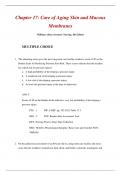
Chapter 17: Care of Aging Skin and Mucous Membranes
MULTIPLE CHOICE 1. The admitting nurse gives the new long-term care facility resident a score of 20 on the Braden Scale for Predicting Pressure Sore Risk. These scores indicate that the resident has which risk for pressure injury? a. A high probability of developing a pressure injury b. A moderate risk of developing a pressure injury c. A low risk of developing a pressure injury d. At least one pressure injury at the time of admission ANS: C Scores of 20 on the Braden Scale ind...
- Package deal
- Exam (elaborations)
- • 16 pages •
MULTIPLE CHOICE 1. The admitting nurse gives the new long-term care facility resident a score of 20 on the Braden Scale for Predicting Pressure Sore Risk. These scores indicate that the resident has which risk for pressure injury? a. A high probability of developing a pressure injury b. A moderate risk of developing a pressure injury c. A low risk of developing a pressure injury d. At least one pressure injury at the time of admission ANS: C Scores of 20 on the Braden Scale ind...
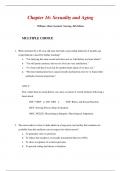
Chapter 16: Sexuality and Aging
MULTIPLE CHOICE 1. What statement by a 65-year-old man who had a myocardial infarction 6 months ago would indicate a need for further teaching? a. “I’m enjoying the same sexual activities now as I did before my heart attack.” b. “I’m still pretty cautious, but our sex lives are very satisfactory.” c. “I’ve been told that I’m at risk for another heart attack if we have sex.” d. “My heart medications have caused erectile dysfunction, but we’ve found other method...
- Package deal
- Exam (elaborations)
- • 13 pages •
MULTIPLE CHOICE 1. What statement by a 65-year-old man who had a myocardial infarction 6 months ago would indicate a need for further teaching? a. “I’m enjoying the same sexual activities now as I did before my heart attack.” b. “I’m still pretty cautious, but our sex lives are very satisfactory.” c. “I’ve been told that I’m at risk for another heart attack if we have sex.” d. “My heart medications have caused erectile dysfunction, but we’ve found other method...
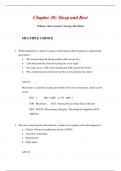
Chapter 20: Sleep and Rest
MULTIPLE CHOICE 1. Which statement by a patient’s spouse would indicate that the patient is experiencing myoclonus? a. “His loud snoring and jerking awake wakes me up, too.” b. “I am black and blue from his kicking me every night.” c. “He wakes up at 2 AM every morning and walks around the house.” d. “His constant leg movements tear up the covers and keep me awake.” ANS: B Myoclonus is a periodic kicking movement of the lower extremities, which can be severe. ...
- Package deal
- Exam (elaborations)
- • 15 pages •
MULTIPLE CHOICE 1. Which statement by a patient’s spouse would indicate that the patient is experiencing myoclonus? a. “His loud snoring and jerking awake wakes me up, too.” b. “I am black and blue from his kicking me every night.” c. “He wakes up at 2 AM every morning and walks around the house.” d. “His constant leg movements tear up the covers and keep me awake.” ANS: B Myoclonus is a periodic kicking movement of the lower extremities, which can be severe. ...
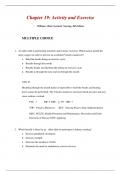
Chapter 19: Activity and Exercise
MULTIPLE CHOICE 1. An older adult is performing isometric and isotonic exercises. Which action should the nurse suggest in order to prevent an accidental Valsalva maneuver? a. Hold the breath during an exercise cycle. b. Breathe through the mouth. c. Breathe deeply and rhythmically during an exercise cycle. d. Breathe in through the nose and out through the mouth. ANS: B Breathing through the mouth makes it impossible to hold the breath, and bearing down cannot be performed. Th...
- Package deal
- Exam (elaborations)
- • 12 pages •
MULTIPLE CHOICE 1. An older adult is performing isometric and isotonic exercises. Which action should the nurse suggest in order to prevent an accidental Valsalva maneuver? a. Hold the breath during an exercise cycle. b. Breathe through the mouth. c. Breathe deeply and rhythmically during an exercise cycle. d. Breathe in through the nose and out through the mouth. ANS: B Breathing through the mouth makes it impossible to hold the breath, and bearing down cannot be performed. Th...

Chapter 18: Elimination
MULTIPLE CHOICE 1. Which nursing action would be effective when assisting an 85-year-old adult with weak abdominal muscles to defecate? a. Encourage the use of a bedpan before getting up in the morning. b. Place a footstool under the feet of the patient when seated on the toilet. c. Insert a finger in the patient’s rectum to stimulate the urge to defecate. d. Instruct the patient to do isometric exercises to strengthen the abdominal muscles. ANS: B Placement of a stool under...
- Package deal
- Exam (elaborations)
- • 15 pages •
MULTIPLE CHOICE 1. Which nursing action would be effective when assisting an 85-year-old adult with weak abdominal muscles to defecate? a. Encourage the use of a bedpan before getting up in the morning. b. Place a footstool under the feet of the patient when seated on the toilet. c. Insert a finger in the patient’s rectum to stimulate the urge to defecate. d. Instruct the patient to do isometric exercises to strengthen the abdominal muscles. ANS: B Placement of a stool under...
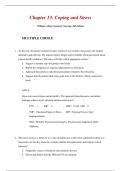
Test Bank for Basic Geriatric Nursing 8th Edition by Patricia A. Williams {Chapter 11-15}
Chapter 11: Self-Perception and Self-Concept Chapter 12: Roles and Relationships Chapter 13: Coping and Stress Chapter 14: Values and Beliefs Chapter 15: End-of-Life Care
- Package deal
- • 5 items •
- Chapter 13: Coping and Stress • Exam (elaborations)
- Chapter 14: Values and Beliefs • Exam (elaborations)
- Chapter 15: End-of-Life Care • Exam (elaborations)
- Chapter 11: Self-Perception and Self-Concept • Exam (elaborations)
- Chapter 12: Roles and Relationships • Exam (elaborations)
Chapter 11: Self-Perception and Self-Concept Chapter 12: Roles and Relationships Chapter 13: Coping and Stress Chapter 14: Values and Beliefs Chapter 15: End-of-Life Care
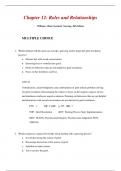
Chapter 12: Roles and Relationships
MULTIPLE CHOICE 1. Which method will the nurse use to help a grieving widow begin the grief resolution process? a. Distract her with social conversation. b. Encourage her to verbalize her grief. c. Point out behaviors that are not helpful to grief resolution. d. Focus on her loneliness and loss. ANS: B Verbalization, acknowledgment, and confrontation of grief initiate problem solving for grief resolution. Encouraging the widow to focus on the negative aspects of loss and loneli...
- Package deal
- Exam (elaborations)
- • 14 pages •
MULTIPLE CHOICE 1. Which method will the nurse use to help a grieving widow begin the grief resolution process? a. Distract her with social conversation. b. Encourage her to verbalize her grief. c. Point out behaviors that are not helpful to grief resolution. d. Focus on her loneliness and loss. ANS: B Verbalization, acknowledgment, and confrontation of grief initiate problem solving for grief resolution. Encouraging the widow to focus on the negative aspects of loss and loneli...
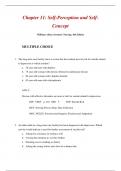
Chapter 11: Self-Perception and Self-Concept
MULTIPLE CHOICE 1. The long-term care facility nurse is aware that the resident most at risk for suicide related to depression is which resident? a. 70-year-old man with diabetes b. 75-year-old woman with chronic obstructive pulmonary disease c. 80-year-old woman with a bipolar disorder d. 85-year-old man with schizophrenia ANS: C Persons with affective disorders are most at risk for suicide related to depression. DIF: 7 REF: p. 218 OBJ: 5 TOP: Suicide Risk KEY: Nur...
- Package deal
- Exam (elaborations)
- • 13 pages •
MULTIPLE CHOICE 1. The long-term care facility nurse is aware that the resident most at risk for suicide related to depression is which resident? a. 70-year-old man with diabetes b. 75-year-old woman with chronic obstructive pulmonary disease c. 80-year-old woman with a bipolar disorder d. 85-year-old man with schizophrenia ANS: C Persons with affective disorders are most at risk for suicide related to depression. DIF: 7 REF: p. 218 OBJ: 5 TOP: Suicide Risk KEY: Nur...

TEST BANK PUBLIC HEALTH NURSING: POPULATION-CENTERED HEALTH CARE IN THE COMMUNITY, 10TH EDITION BY STANHOPE
Chapter 28: Care of Patients with Disorders of the Upper Gastrointestinal System |deWit: Medical-Surgical Nursing: Concepts & Practice, 3rd Edition
Chapter 48: Immunostimulants and Immunomodulators Introductory Clinical Pharmacology 12th Edition by Susan M Ford
Chapter 47: Vaccines Introductory Clinical Pharmacology 12th Edition by Susan M Ford
Chapter 43: Male and Female Hormones Introductory Clinical Pharmacology 12th Edition by Susan M Ford